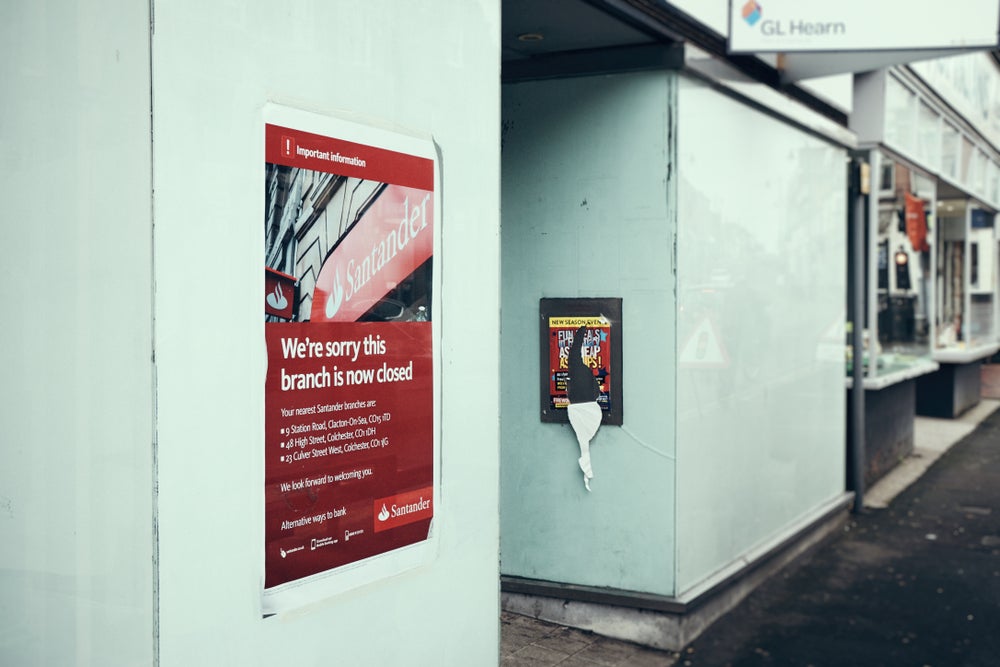
It all seemed such a good deal, as recently as last July. I broke off from my holidays to tell BBC radio Five Live, Radio 2, the rolling BBC news channel and just about anyone else that would listen, what a good deal the Cooperative Bank had struck to snap up 632 branches from Lloyds Banking Group, writes Douglas Blakey
The Coop was to pay a mere £350m up-front for the branches with up to a further £400m based on the performance of the branches over the next 15 years.
I may even have called it a bargain.
Okay, to be strictly accurate, I actually called it something approaching an absolute steal.
By contrast, Santander had agreed to acquire 316 branches from Royal Bank of Scotland in a deal worth around £1.65bn.
How well do you really know your competitors?
Access the most comprehensive Company Profiles on the market, powered by GlobalData. Save hours of research. Gain competitive edge.

Thank you!
Your download email will arrive shortly
Not ready to buy yet? Download a free sample
We are confident about the unique quality of our Company Profiles. However, we want you to make the most beneficial decision for your business, so we offer a free sample that you can download by submitting the below form
By GlobalDataSantander subsequently pulled out of that deal, blaming IT challenges relating to the acquisition.
That argument was rather less than convincing, given Santander’s stellar record in tackling IT issues arising from its earlier purchases of Abbey, Bradford & Bingley and Alliance & Leicester.
Had Coop managed to conclude its agreement with Lloyds, it would have had a UK current account market share of around 7% (up from 3%) and would become the 7th largest UK bank by current account market share and the 6th largest bank as ranked by branches.
Lloyds dominates the current account market share with 31%, ahead of RBS NatWest with 16% and Barclays and HSBC/First Direct each with 14% and Santander with 11%.
The relatively modest Coop branch network of 340 units would have almost trebled to more than 970 outlets, once it rebranded 283 Lloyds TSB branches in England and Wales, 164 Cheltenham & Gloucester branches and 185 Lloyds TSB Scotland branches.
Today, the Coop/Lloyds deal is in tatters. And today on BBC news I felt a little uncomfortable when I suggested that perhaps, on reflection, the Coop was acting prudently in not stretching itself to finalise the branch purchases.
I would be quite happy if everything I had written and said regarding the Lloyds-Coop deal last year could be quietly and immediately deleted.
According to the Coop, it has chucked in the towel because of the current economic environment.
The economy is none too chipper, but arguably not a lot has changed since last July.
The Coop also argues that the increasing regulatory requirements on banks mean that the deal no longer makes sense.
Again, pull the other one.
There is an increasing regulatory burden on banks, it is true.
There are these tiresome new rules for the banks relating to miss-selling; no more jackpots await such as the bonanza they struck from selling PPI insurance to customers who might want to take out a loan.
There are also tighter rules relating to putting away adequate levels of capital for a rainy day.
All of these rules were well known last July.
It would be more accurate to say that the Coop has had a bad year. It lost £600m in fiscal 2012 and has faced bigger challenges to fund the deal than they – and this writer – forecast a mere nine months ago.
It may also be fair to suggest that the rapid transformation in the way the majority of us do our banking is swaying thinking within the Coop?
‘The branch is dead’ and ‘the branch has no future’ are ridiculously gloomy and inaccurate regular forecasts from digital (internet and mobile) banking evangelists.
But, and it is a big but the size of a flagship Apple-type banking store, we are using branches less and less.
Branches need staffing and branches are expensive compared to offering digital banking.
That kind of thinking is heard more and more from senior retail bankers.
Perhaps the recent explosion in customer numbers using internet and mobile banking means that the Coop’s enthusiasm to treble its high street presence is on the wane.
In the UK, 55% of internet users accessed an online banking site in December 2012 – ranking the UK as the 4th most enthusiastic internet banking country within the EU27 – against the European average of 39.9%.
Last year, Lloyds for example, has over 10m unique visitors to its internet banking site, up 14% year-on-year; RBS NatWest and Barclays followed with 6.4m and 6.3m visitors respectively.
For the record, HSBC (with 3.4m) and Santander (2.6m) rounded off the top 5.
Smartphone penetration in the UK has now reached 64%, again, way ahead of the European average.
All UK banks, including now the Coop, offer some form of mobile banking.
Tablet computer use is also going through the roof and banks are slowly but surely starting to offer tablet banking as an additional service.
For the Coop, there remains the untapped potential of using more if its retail supermarkets to offer a dedicated area offering banking services.
The background to the sale of the branches (known as Project Verde), was forced by European Union regulations after Lloyds was bailed out by the UK taxpayer to the tune of £20bn during the 2008 financial crisis.
So what now?
Estimates suggest that Lloyds has already spent almost £1bn during the Verde project in an effort to dispose of the branches.
The abortive deal will also have cost the Coop an eye-watering sum.
Lloyds will go back to the drawing board and will dust off its plans for an IPO: in other words, try and sell the branches in the market.
The timing is not great. Next year will be a busy time for branch sales.
RBS is still to dispose of the 318 outlets it failed to sell to Santander and needs to get a move on before it incurs the wrath of the EU.
Neither RBS nor Lloyds are likely to be thrilled with the eventual sales proceeds.
One last thought arises from the branches sales saga.
Banks, including Coop and Santander, may well be proved correct if they believe that they can meet their expansion targets without the need to bulk up their branch networks.
Reliance on the digital banking channels will however mean that they have no option but to offer reliable mobile and internet banking services offering a compelling customer experience.
Due emphasis requires to be placed on the word ‘reliable’, as RBS knows to its embarrassment following its two high profile service collapses in the past year.







